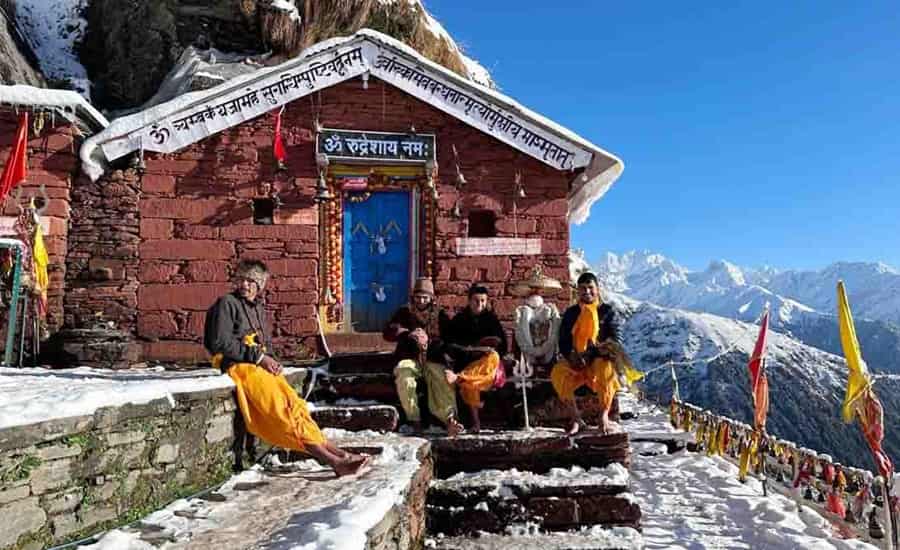Rudranath Temple, a significant pilgrimage place dedicated to Lord Shiva is also a part of Panch Kedar. It is a place where the Rudra avatar of Lord Shiva is worshipped. It is situated at an elevation of 3600 meters. The temple of Rudranath serves as a solace paradise for devotees. It is a realm of eternal peace and divine wisdom where every pilgrim must seek divine blessings once in a lifetime. To make your travel experience to the difficult terrains of Himalayan region, we have provided detailed information on the best time to visit Rudranath temple covering season changes, weather conditions and temperature variations. It will be easy for you to understand the location and plan in advance your Rudranath Pilgrimage Tour.

Best Season to Visit Rudranath Temple
Summer (April to June)
- Summer is a peak pilgrimage tourism season for Rudranath Temple. Summer offers bearable weather for sightseeing. The temperature during this time ranges from 10°C to 20°C during the day, making it very comfortable for pilgrims to travel to the temple for darshan and also explore nearby locations.
- The snow begins to melt in summer which will unveil lush green meadows, blooming flowers, and breathtaking landscapes of the Himalayan region. The clear skies offer excellent visibility to navigate hilly areas, allowing travelers to see the beauty of the Himalayas.
- The summer months are best for trekking enthusiasts as the trails will be dry and accessible to view Rudranath Temple.
Worst Season to Travel to Rudranath Temple- (Popular Opinion)
Monsoon (July to September)
- Monsoon season is the harbinger of rain so heavy rainfall is expected during this time. Rainfall will bring landslides and roadblocks which will hinder devotees to get darshan of Lord Shiva at Rudranath Temple. Therefore, it is technically one of the worst times to travel in Rudranath Temple and not recommended.
- The incessant rain also poses risks of slippery trails and flooding which will be dangerous for pilgrims and tourists. Moreover, cloud cover will obscure the road and you will not be able to enjoy mountain views and roads.
Post Monsoon Time to Visit Rudranath Temple
Autumn (October to November)
- Autumn is another favorable time to visit Rudranath Temple. The skies during this time will be clear. The temperature will be good for exploration with minimum precipitation. It ranges from 5°C to 15°C, offering comfortable conditions for exploring nearby places in and around Rudranath Temple.
- Post Monsoon gives travelers unique views. From a photographer’s perspective, the surrounding landscapes show vibrant hues of red, orange, and gold as the foliage starts transforming which makes everything very scenic.
- For trekkers, the trails become more accessible after the rains which will make the journey to Rudranath Temple very comfortable.
Considering Rudranath Temple in Freezing Degrees
Winter (December to March)
- Winter covers Rudranath Temple in snow, which makes the place tranquil and enchanting but you need to carefully consider all the aspects of surviving harsh weather conditions before visiting Rudranath in this season.
- The temperature in winter in Rudranath can go up to below freezing. The temperature during the day ranges from -5°C to 5°C. Heavy snowfall blocks the road and makes the temple road inaccessible for the pilgrims.
- Despite the challenges, winter offers a unique opportunity to witness the temple covered in snow. But, it is advisable to be well-prepared to survive the cold with adequate clothing and gears.
Weather Temperatures at Rudranath Temple
It is very important to understand the temperatures at Rudranath Temple to plan your pilgrimage tour in advance and pack accordingly. Before reaching here, also check weather updates on the official forecast site to know more about the weather in detail. Here’s an outline of average temperatures throughout the year:
- Summer (April to June): Daytime temperatures in summer in Rudranath range from 10C to 20°C. Nights will be cooler, with temperatures dropping to 5°C to 10°C.
- Monsoon (July to September): Daytime temperatures in Monsoon in Rudranath range from 10°C to 15°C. There will be relatively high humidity and rainfall during this time. The temperatures range from 5°C to 10°C.
- Autumn (October to November): Daytime temperatures in Rudranath in autumn range from 5°C to 15°C. There will be cooler temperatures in November. Nights will be chilly, with temperatures ranging from 0°C to 5°C.
- Winter (December to March): Daytime temperatures in winter in Rudranath range from -5°C to 5°C. There will be sub-zero temperatures experienced during the night. You will see heavy snowfall which can also further lower the temperatures.
Conclusion
Choosing the best time to visit Rudranath Temple will definitely depend on the interest of the pilgrims and traveller. A traveller needs to think about various aspects like weather conditions, accessibility, and personal preferences. While summer and autumn are generally recommended as it has the best weather conditions. In the end, it’s up to you which weather most suits you according to your comfort level. Always remember, each season offering has its own charm and allure amidst the majestic Himalayan region.
Also Read:

 Call
Call WhatsApp
WhatsApp Enquiry
Enquiry